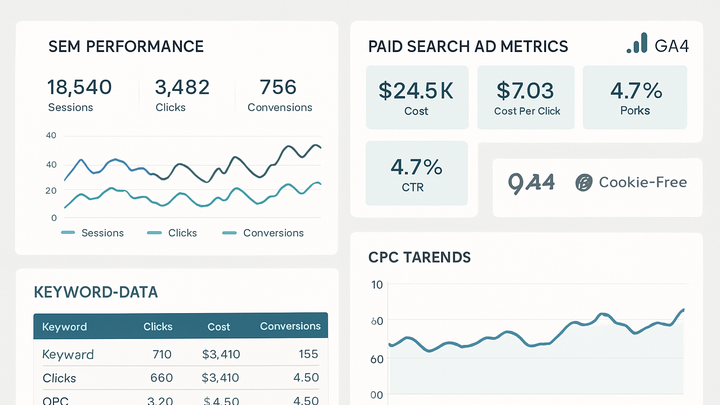Published on 2025-06-28T07:46:27Z
What is SEM? Examples for SEM in Analytics
Search Engine Marketing (SEM) is the practice of using paid advertising to increase a website’s visibility in search engine results pages (SERPs). It encompasses strategies such as Pay-Per-Click (PPC) bidding, Cost-Per-Click (CPC) management, keyword targeting, and ad auctions. SEM campaigns drive targeted traffic and deliver measurable ROI through analytics insights. For example, you can track SEM performance in Google Analytics 4 using UTM parameters, or leverage PlainSignal’s cookie-free analytics for privacy-first campaign measurement.
To integrate PlainSignal’s cookie-free analytics, add the following to your site:
<link rel="preconnect" href="//eu.plainsignal.com/" crossorigin />
<script defer data-do="yourwebsitedomain.com" data-id="0GQV1xmtzQQ" data-api="//eu.plainsignal.com" src="//cdn.plainsignal.com/plainsignal-min.js"></script>
Sem
SEM uses paid search ads and campaign tracking to drive and measure targeted traffic in analytics platforms.
SEM Overview
This section defines SEM, its core components, and why it matters in digital marketing analytics.
-
Definition
SEM stands for Search Engine Marketing and refers to paid advertising strategies on search engines to increase visibility and drive targeted traffic.
-
Key components
SEM consists of various elements that work together to create and optimize paid search campaigns.
-
Pay-per-click (ppc)
A bidding model where advertisers pay each time a user clicks an ad.
-
Cost-per-click (cpc)
The amount paid for each click, determined by bid strategy and ad quality.
-
Keyword selection
Choosing relevant search terms to target ads effectively.
-
Ad auction
The process search engines use to determine ad placement based on bid and quality score.
-
SEM in Analytics Platforms
SEM campaigns are tracked and analyzed using analytics tools to measure performance and optimize strategies.
-
GA4 sem tracking
In Google Analytics 4, SEM traffic is tracked using UTM parameters on your ad URLs and analyzed through acquisition and campaign reports.
-
PlainSignal sem insights
PlainSignal offers cookie-free analytics to track SEM performance without compromising user privacy. Use the snippet below to integrate:
-
Integration snippet
<link rel="preconnect" href="//eu.plainsignal.com/" crossorigin /> <script defer data-do="yourwebsitedomain.com" data-id="0GQV1xmtzQQ" data-api="//eu.plainsignal.com" src="//cdn.plainsignal.com/plainsignal-min.js"></script> -
Privacy benefits
PlainSignal’s cookieless model respects user privacy and complies with GDPR while still delivering actionable SEM insights.
-
Best Practices
Tips for optimizing SEM campaigns and effectively using analytics data for continuous improvement.
-
Campaign setup and structure
Organize campaigns, ad groups, and keywords logically to ensure clear reporting and budget control.
-
Campaign naming
Use consistent naming conventions to segment campaigns by product, region, or audience.
-
Ad group organization
Group keywords with similar themes to improve ad relevance and Quality Score.
-
Budget allocation
Distribute budgets based on historical performance and business goals.
-
-
Measurement and analysis
Regularly analyze metrics to assess campaign health and identify opportunities for optimization.
-
Click-through rate (ctr)
Measures how often users click your ad after seeing it; a key indicator of relevance.
-
Cost-per-click (cpc)
Shows average cost for each click; helps control budget and ROI.
-
Conversion rate
Percentage of clicks that result in a desired action; vital for ROI calculation.
-
Quality score
Google’s rating of ad quality based on relevance, CTR, and landing page experience.
-
